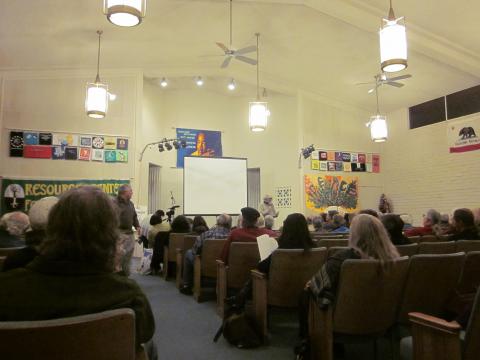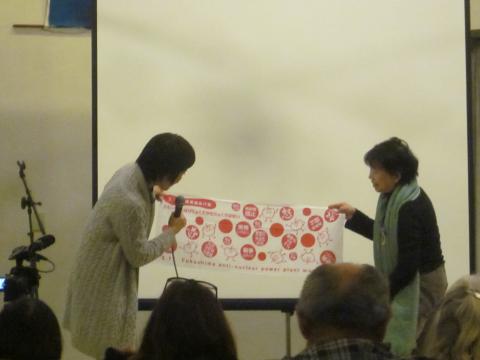A January event co-sponsored by Santa Cruz Sierra Club, No Nukes Action Committee, 350.org, and other organizations shed light on the ongoing health and environmental tragedies in Fukushima, Japan. Article by UCSC Sierra Club intern Colleen McCullough. Photographs by Melissa Ott unless otherwise noted.
Reading a newspaper headline that reads “Japanese government to dump thousands of gallons of nuclear waste into the Pacific Ocean” sounds like a dystopian, too-bad-to-be-true conspiracy theory. Those who attended the recent Fukushima event at the Resource Center for Nonviolence have spent the last couple weeks wishing it really was some conspiracy theory, only to be reminded of the reality of this news.
On Thursday, January 22, 2015, the Sierra Club, No Nukes Action Committee, Santa Cruz Peace and Freedom Party, Desalination Alternatives, Resource Center for Nonviolence, Romero Institute, Santa Cruz Indigenous Solidarity, 350 Santa Cruz, and Santa Cruz Women's International League for Peace and Freedom hosted an event, Report from Fukushima and Korea, at the Resource Center for Nonviolence, where Chieko Shiina spoke out about the ongoing effects of the Fukushima nuclear disaster, and UC Santa Cruz professor Christine Hong spoke about the militarization of Asia, focusing on Korea. To provide a glimpse of what the event was about, this article examines the information and stories shared by Chieko Shiina.

Report from Fukushima and Korea held at the Resource Center for Nonviolence
Shiina, a former organic farmer turned anti-nuclear activist who lives in Fukushima, Japan, shared through a translator about her experience there since March 2011, when the Fukushima Daiichi Nuclear Power Plant was severely damaged by a major earthquake and, as a result, radiation was released in large quantities. How large? Well, when the atomic bomb exploded over Hiroshima, it released 89 terabecquerels of cesium, a radioactive isotope. In Fukushima after the earthquake, the initial damage released somewhere between 5,000 to 15,000 terabecquerels of cesium-134, more than 56 times the amount in Hiroshima. This nuclear disaster contaminated crops, water, and the communities in and surrounding Fukushima.

Fukushima is located an hour from Tokyo and is a moderately sized city. The city is home to volcanic landscapes, hot springs, and farmers. Source: www.japan-guide.com
This nuclear catastrophe has been exacerbated by the Japanese government’s denial of the disaster’s effects. Japanese citizens are still affected daily by the consequences of the government’s inaction. After the accident children and adults were exposed to large amounts of radiation and there has been an equally large spike in cancer, particularly thyroid cancer. Because the Japanese government is denying the severity of the situation, it is difficult to find concrete statistics about cancer rates before and after the disaster, but all sources, including those published by the Japanese government, have shown an increase in cancer. It is important to note that the cancer reported is just the tip of the iceberg. Many cases of cancer are going unreported or even undiagnosed. Shiina shared that the Japanese government, however, has assured citizens that the nuclear accident is not the cause of the increase of cancer, or that many peoples’ symptoms are not cancer. Shiina runs one of the only independent clinics in Japan that is truthfully diagnosing and treating the health problems caused by the disaster. The government is downplaying the radiation levels still present in areas surrounding the disaster and has started a repatriation campaign, recommending for people to move back to their homes, despite it still being unsafe.

Shiina and her translator, showing a hand cloth depicting symbolism of the consequences of the nuclear disaster
This is not just a social justice issue, however. Our environment at a global level is also threatened, which is where the Sierra Club’s anti-nuke stance is relevant. Currently, there is a shortage of tanks holding radioactive water and they are beginning to leak. According to National Geographic, "300 tons (71,895 gallons/272,152 liters) [of nuclear waste contaminated water] are pouring into the sea each day, enough to fill an Olympic-size swimming pool every eight days."
Because these tanks are ineffective, the Japanese government has proposed doing away with them altogether and effectively disposing of the radioactive water into the Pacific Ocean. Disconcertingly, this announcement has accompanied very little panic or reporting from American sources (evidently lifestyles of the rich and famous are more interesting to worry about than radiation at our nearby beaches). This proposed “solution” to Japan’s nuclear problems is a huge red flag and an action that must be prevented by all means to avoid leaking radioactive waste into our coastal waters. It is imperative that the water is not released into the ocean and is stopped from leaking into the earth at the site of the tanks.
Contamination of the earth, which is already occurring from the situation as it stands, is adversely increasing the health issues discussed previously, because it pollutes the food and water consumed by people both close to and far away from the incident. If the water is released into the Pacific Ocean, this will have a staggering effect on the ecosystems in the ocean as well as around the world.
Our own Pacific coast is in danger of contamination. Our agricultural and aquacultural industries would be contaminated, leading to contamination of the people who live here. It is appalling to hear this; one would think that an impending disaster like this one, looming at our shores, would be on the front of every newspaper and at the top of Congress’s agenda. It’s not, which is why the Sierra Club and other concerned citizens are doing our part to raise awareness about the dangers associated with nuclear energy--both in the current example in Japan and in nuclear energy plants around the world. In addition to educating, the audience is given strategies to help - including writing and calling our Congressmen and women to address this issue.